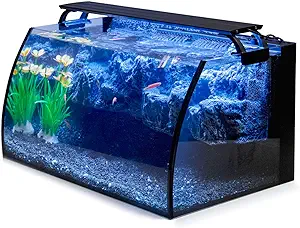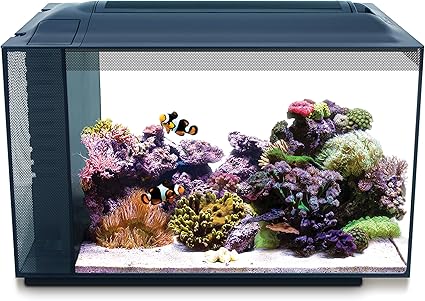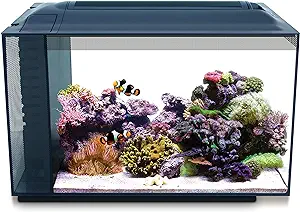Selecting the right fish tank is crucial in setting up a thriving aquarium. Whether you’re drawn to the vibrant colors of saltwater fish or the serene beauty of a freshwater setup, choosing the appropriate tank will impact the happiness of your aquatic pets and keep them happy. This guide will explore three types of saltwater and freshwater tanks, providing essential details on their features, benefits, and considerations. With this information, you can make an informed decision and create the perfect aquatic environment.
Freshwater Fish Tanks
1. Standard Glass Aquariums:
Standard glass aquariums are the most common type of freshwater tank, ideal for beginners due to their durability and affordability.

Size and Shape:
They are available in various sizes, typically 10 to 100 gallons. Rectangular shapes are the most common, but other shapes are also available.
Benefits:
Glass tanks are scratch-resistant and provide excellent clarity. They are widely available and cost-effective, making them perfect for first-time aquarists.
Considerations:
Glass tanks are heavier than acrylic tanks and can be more challenging to move. Ensure the tank is placed on a sturdy stand to support its weight.
2. Bowfront Aquariums:
Bowfront aquariums feature a curved front panel, adding a unique aesthetic to your aquarium setup.

Size and Shape:
Typically available in sizes ranging from 20 to 90 gallons, with a distinctive curved front for a panoramic view.
Benefits:
The curved design enhances the visual appeal of your tank, providing a more immersive viewing experience. It’s a stylish option for those who want their aquarium to be a focal point in the room.
Considerations:
Bowfront tanks can be more expensive than standard glass tanks. The curved glass may cause slight distortion in viewing, requiring careful placement to prevent stress on the glass.
3. All-in-One Freshwater Aquariums:
All-in-one aquariums include everything you need to start a freshwater tank, from filtration to lighting.
Size and Shape:
They typically range from 5 to 50 gallons and come in various shapes, including rectangular, cube, and bowfront designs.
Benefits:
These kits are convenient for beginners, as they include built-in filtration, lighting, and sometimes heating. They simplify the setup process and ensure compatibility between components.
Considerations:
While convenient, these tanks may have limited customization options. The included equipment may only sometimes be of the highest quality, so consider upgrading as needed.
Saltwater Fish Tanks
1. Reef-Ready Aquariums:
Reef-ready aquariums are for saltwater enthusiasts who want to create a thriving coral reef environment.

Size and Shape:
They are typically available in sizes ranging from 40 to 200 gallons, often with built-in overflow systems.
Benefits:
These tanks are pre-drilled with overflow systems for easy sump integration, which is essential for maintaining water quality in a reef environment. They are ideal for housing corals, invertebrates, and reef-safe fish.
Considerations:
Reef-ready tanks can be more expensive and need additional equipment such as protein skimmers and specialized lighting. They also demand more maintenance and water quality management.
2. Nano Reef Tanks:
Nano reef tanks are compact saltwater aquariums designed for small-scale reef setups, perfect for those with limited space.

Size and Shape:
They typically range from 5 to 30 gallons and are often cube or rectangular.
Benefits:
These space-efficient tanks can be placed in small areas like desks or countertops. They provide a manageable way to experience reef keeping without needing a large tank.
Considerations:
Nano reef tanks require careful monitoring of water parameters, as fluctuations can happen quickly in smaller volumes. They may also limit the types of corals and fish you can keep.
3. Fish-Only with Live Rock (FOWLR) Tanks:
FOWLR tanks are perfect for saltwater enthusiasts who want to focus on keeping fish without the complexity of maintaining corals.
Size and Shape:
Available in various sizes, typically starting at 30 gallons and up. Shapes can vary from standard rectangles to custom designs.
Benefits:
These tanks are less demanding than reef tanks, as they don’t require the specialized lighting and water chemistry needed for coral growth. Live rock provides biological filtration, enhancing water quality and providing a natural environment for fish.
Considerations:
While less complex than reef tanks, FOWLR setups still require attention to water quality and filtration. They also require high-quality live rock and carefully selecting compatible fish species.
Conclusion:
Choosing the right fish tank is the foundation of a successful aquarium, whether freshwater or saltwater. Standard glass aquariums and all-in-one kits offer simplicity and convenience for freshwater enthusiasts, while reef-ready and FOWLR tanks cater to the needs of saltwater hobbyists. Consider your space, budget, and experience level when selecting a tank, and you’ll be well on your way to creating a stunning aquatic display.
Disclosure: This page may contain an affiliate link to Amazon.com. We might receive a commission if you follow them and purchase anything from the recommended products. I can assure you that I never recommend anything I don’t trust. Thanks for supporting positvelypets.com!





Pingback: The Wonderful & Interesting World of Blennies - Positvley Pets
Pingback: Owning Betta Fish: Everything You Need to Know - Positvley Pets